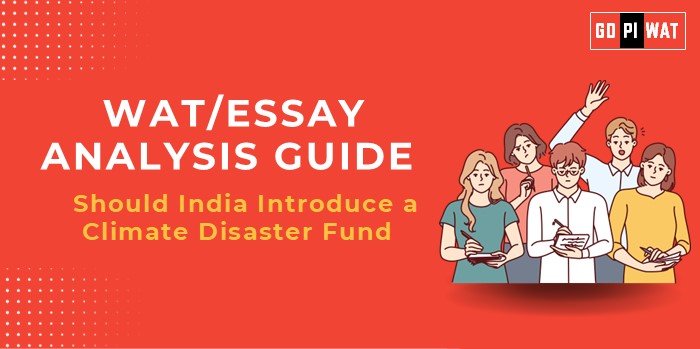📋 Written Ability Test (WAT)/Essay Analysis Guide: Should India Introduce a Climate Disaster Fund?
🌍 Understanding the Topic’s Importance
With increasing frequency and intensity, climate-induced disasters pose significant challenges to India’s socio-economic stability. Cyclones, floods, and droughts result in substantial economic losses, displacement, and loss of life. Establishing a dedicated Climate Disaster Fund can provide a proactive solution to enhance resilience and mitigate these impacts. For B-school aspirants, this topic connects with risk management, public policy, and sustainable finance, offering a balanced perspective on economic growth and environmental protection.
⏱️ Effective Planning and Writing
- Planning (5 minutes): Brainstorm key points and structure the essay.
- Writing (20 minutes): Develop a well-organized argument.
- Reviewing (5 minutes): Refine content for clarity and accuracy.
Preparation Tips:
- Research statistics on India’s economic losses from climate disasters.
- Highlight international models of disaster resilience and dedicated funds.
- Structure the essay logically: introduction, achievements, challenges, and future outlook.
📖 Introduction Techniques for Essays
- Data-Driven Approach: “India faces an average annual economic loss of $9.8 billion due to climate disasters. A Climate Disaster Fund could offer sustainable solutions to address these challenges effectively.”
- Contrasting Perspectives: “While India’s rapid economic progress positions it as a global leader, its vulnerability to climate disasters highlights the need for enhanced disaster resilience.”
📊 Structuring the Essay Body
🏆 Achievements
- 🌀 Odisha’s Preparedness: Reduced cyclone-related fatalities through robust community disaster management practices.
- 🌦️ Technological Advancements: Improved meteorological forecasting and early warning systems have enhanced disaster preparedness.
⚠️ Challenges
- 💰 Funding Gaps: Existing funds like the NDRF are inadequate for large-scale disasters.
- ⏱️ Administrative Delays: Bureaucratic hurdles slow down resource allocation.
- 🏘️ Community-Level Disparities: Lack of grassroots capacity building increases rural vulnerability.
🔮 Future Outlook
- 🌱 Green Bonds: Mobilize private investments for disaster resilience projects.
- 🤖 AI and Predictive Modeling: Use technology for real-time monitoring and efficient resource allocation.
- 🤝 Public-Private Partnerships (PPP): Engage the private sector for resilient infrastructure and disaster insurance products.
✅ Concluding Effectively
- Balanced Perspective: “A Climate Disaster Fund is a proactive step, but its success depends on transparent governance, robust implementation, and active community participation.”
- Global Comparison: “Drawing lessons from countries like Japan and Bangladesh, India can establish a fund that balances economic growth and climate resilience.”
✍️ Sample Short Essays
Balanced Perspective
“India’s escalating climate risks demand a specialized Climate Disaster Fund for timely response and resource allocation. While existing frameworks like NDRF show promise, a dedicated fund could bridge critical gaps. However, transparency and inclusivity are paramount to its success.”
Solution-Oriented
“A Climate Disaster Fund is essential for enhancing India’s disaster resilience. Integrating AI for predictive modeling and fostering public-private collaborations can address current gaps, positioning India as a leader in climate risk mitigation.”
Global Comparison
“Japan’s disaster preparedness model and Bangladesh’s community-based initiatives highlight the effectiveness of dedicated funds. India can learn from these examples to establish a Climate Disaster Fund that ensures sustainability and resilience.”
📚 Key Takeaways for B-School Aspirants
- 💡 Understand Risk Management: Explore the role of financial mechanisms in mitigating risks.
- 🌍 Analyze Sustainability: Study interdisciplinary applications of governance, technology, and finance in disaster management.
- 📈 Apply Insights: Develop models for fund management that emphasize accountability and inclusivity.


